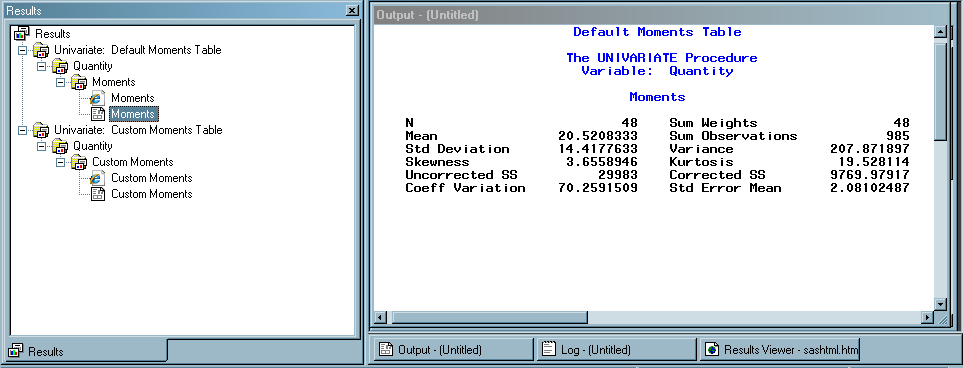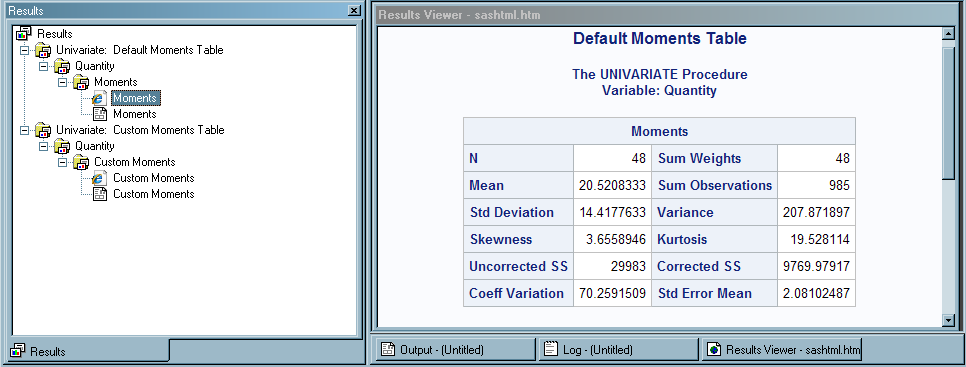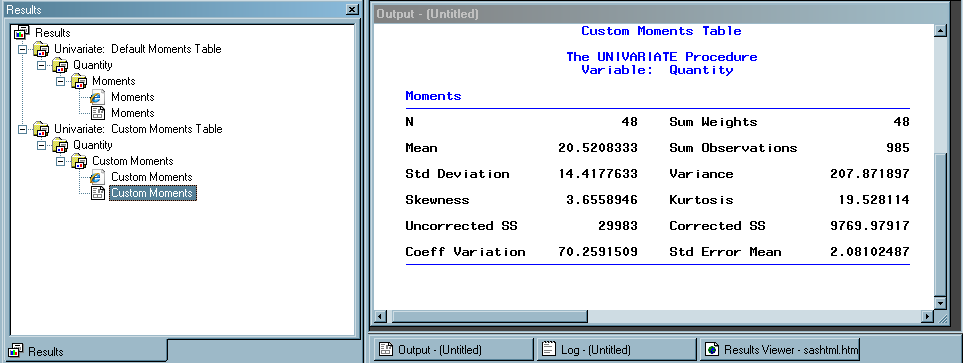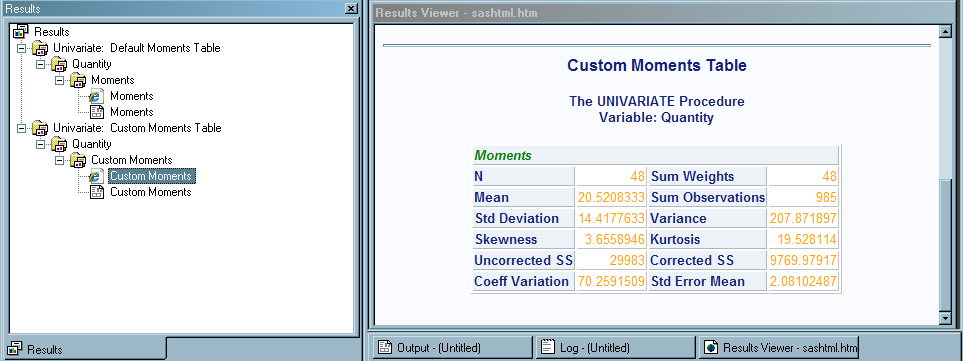TEMPLATE Procedure: Creating Table Templates
- Syntax
 Procedure SyntaxCELLSTYLE AS StatementCOLUMN StatementCOMPUTE AS StatementDEFINE StatementDEFINE COLUMN StatementDEFINE FOOTER StatementDEFINE HEADER StatementDEFINE TABLE StatementDYNAMIC StatementEDIT StatementEND StatementFOOTER StatementHEADER StatementMVAR StatementNMVAR StatementNOTES StatementTEXT StatementTEXT2 StatementTEXT3 StatementTRANSLATE INTO Statement
Procedure SyntaxCELLSTYLE AS StatementCOLUMN StatementCOMPUTE AS StatementDEFINE StatementDEFINE COLUMN StatementDEFINE FOOTER StatementDEFINE HEADER StatementDEFINE TABLE StatementDYNAMIC StatementEDIT StatementEND StatementFOOTER StatementHEADER StatementMVAR StatementNMVAR StatementNOTES StatementTEXT StatementTEXT2 StatementTEXT3 StatementTRANSLATE INTO Statement - Overview
- Concepts
- Using
- Examples
 Editing a Table Template That a SAS Procedure UsesComparing the EDIT Statement to the DEFINE TABLE StatementCreating a New Table Template Setting the Style Element for Cells Based on Their ValuesSetting the Style Element for a Specific Column, Row, and CellCreating Master TemplatesTable Header and Footer Border Formatting
Editing a Table Template That a SAS Procedure UsesComparing the EDIT Statement to the DEFINE TABLE StatementCreating a New Table Template Setting the Style Element for Cells Based on Their ValuesSetting the Style Element for a Specific Column, Row, and CellCreating Master TemplatesTable Header and Footer Border Formatting
Example 1: Editing a Table Template That a SAS Procedure Uses
| Features: |
EDIT statement
|
| Other features: |
|
| Data set: | Exprev |
Details
This example customizes
the table template for the Moments output object from PROC UNIVARIATE.
The first program uses the table template that SAS supplies to generate
both LISTING output and HTML output of the Moments object.
Note: This example uses filenames
that might not be valid in all operating environments. To successfully
run the example in your operating environment, you might need to change
the file specifications. See ODS HTML Statements for Running Examples in Different Operating Environments.
Program 1: Using the Default Table Template That SAS Provides
options nodate pageno=1 pagesize=60 linesize=72;
ods listing;
ods select moments;
proc univariate data=exprev mu0=3.5; var Quantity; title "Default Moments Table"; run;
ods listing close;
Program Description
Create the LISTING output.The
ODS LISTING statement opens the LISTING destination and creates LISTING
output.
Select the output objects for the report.The ODS SELECT statement sends one output object,
Moments, to the open ODS destinations. Both the LISTING and the HTML
destinations are open.
To learn the names
of the output objects, run the procedure with the ODS TRACE ON statement
in effect. For more information see ODS TRACE Statement.
ods select moments;
Compute the descriptive statistics for one variable. PROC UNIVARIATE computes the univariate statistics
for one variable, Quantity. It uses the default table template, Base.Univariate.Moments
from the template store Sashelp.Tmplmst.
Program 2: Using a Customized Table Template
ods path sasuser.templat(update) sashelp.tmplmst(read);
proc template; edit base.univariate.moments;
double_space=on; underline=on; overline=on;
label="Custom Moments";
double_space=on;
style=data{color=orange fontstyle=italic};
edit head;
style=header{color=green fontstyle=italic};
just=left;
end; end; run;
ods listing;
ods select moments;
proc univariate data=exprev mu0=3.5; var Quantity; title "Custom Moments Table"; run;
ods listing close;
proc template; delete base.univariate.moments; end; title;
Program Description
Specify the search path in order to locate the table template. The ODS PATH statement specifies which locations
to search for definitions or templates that were created by PROC TEMPLATE,
as well as the order in which to search for them. The statement is
included to ensure that the example works correctly. However, if you
have not changed the path, you do not need to include this statement
because it specifies the default path.
Create a modified table template Base.Univariate.Moments. The EDIT statement looks in the available template
stores for a table template called Base.Univariate.Moments. By default,
it first looks in Sasuser.Templat, but it finds nothing. Next, it
looks in Sashelp.Tmplmst, which contains the table templates that
SAS provides. Because the EDIT statement can read this template, this
is the one that it uses. The program does not specify a destination
for the edited template, so PROC TEMPLATE writes to the first template
store in the path that it can write to, which is Sasuser.Templat.
Therefore, it creates a table template of the same name as the original
one in Sasuser.Templat.
To learn the name of
the table template that a procedure uses, run the procedure with the
ODS TRACE ON statement in effect.For more information see ODS TRACE Statement.
proc template; edit base.univariate.moments;
Specify changes to the Moments output object for the
LISTING output. These three table attributes
affect the presentation of the Moments output object in the listing
output. They have no effect on its presentation in the HTML output.
DOUBLE_SPACE= creates double spaces between the rows of the output
object. OVERLINE= and UNDERLINE= draw a continuous line before the
first row of the table and after the last row of the table.
Specify changes to the Moments output object for the
HTML destination. These three table
attributes affect the presentation of the Moments output object in
the HTML output. DOUBLE_SPACE=ON specifies to double space between
the rows of the table. The STYLE= statements specify a color and font
style for the cell data. The LABEL= attribute changes the label that
appears in the Results window from “Moments” to “Custom
Moments”.
Modify a table element.
The following EDIT statement edits the table element Head within the
table template.
Modify the appearance of the header. The STYLE= attribute alters the style element that
produces the Head table element. The style element Header is defined
in the default style, Styles.HTMLBlue. Many procedures, including
PROC UNIVARIATE, use this style element to produce headers for tables
and columns. In this case, the STYLE= attribute specifies green for
the foreground color and italic for the font style. All other attributes
that are included in Header remain in effect. The STYLE= attribute
affects only the HTML output.
For information about
viewing a style, see Styles That Are Shipped with SAS Software. For a table of style
element names, see ODS Style Elements.
style=header{color=green fontstyle=italic};Left-justify the header text. The
JUST= attribute left-justifies the text of the header in both the
listing and the HTML output.
Stop the editing of the table element and the table template. The first END statement ends the editing of the
table element Head. The second END statement ends the editing of the
table Base.Univariate.Moments.
Create the LISTING output.The
ODS LISTING statement opens the LISTING destination and creates LISTING
output.
Select the output objects for the report. The ODS SELECT statement sends one output object,
Moments, to the open ODS destinations. Both the LISTING and the HTML
destinations are open. To learn the names of the output objects, run
the procedure with the ODS TRACE ON statement in effect.
Compute the descriptive statistics for one variable. PROC UNIVARIATE computes the univariate statistics
for one variable, Quantity. The actual results of the procedure step
are the same in this case, but they are presented differently because
the procedure uses the edited table template. It does so because when
it looks for Base.Univariate.Moments, it looks in the first template
store in the path, Sasuser.Templat. If you wanted to use the table
template that is supplied by SAS, you would have to change the path
with the ODS PATH statement.
See also: ODS PATH Statement.
proc univariate data=exprev mu0=3.5; var Quantity; title "Custom Moments Table"; run;
Stop the creation of the LISTING output. The ODS LISTING CLOSE statement closes the LISTING
destination and all the files that are associated with it. You must
close the destination before you can view the output.
Remove the customized moments table template from Sasuser.Templat.The DELETE statement removes the customized moments
table that was created in this example. When using the DELETE statement,
ODS looks for base.univariate.moments in
Sasuser.Templat first. If it is there, it will delete it. If not,
it will search Sashelp.Tmplmst.



